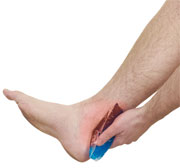Plantar Fasciitis Braces in Sam Tung Uk HKSAR
Podiatrists for Plantar Fasciitis Treatment in Sam Tung Uk HKSAR, China

Managing Achilles Tendon Injuries Achilles tendon discomfort is a common running injury that affects the lower calf/heel area. Usage practical sports training strategies, such as using the right shoes and extending before activities. Practically all the force produced when you toe off" the ground during running is transferred by the Achilles, and this force can be as much as 3 times your body weight. My conditioning was back on track and I started playing complete field soccer once more with no heel discomfort. Ice: Use an ice bag wrapped in a towel or a cold compress to your tendon for 15 minutes or more after you work out or if you feel pain in the tendon. The Achilles tendon is the thickest and strongest tendon in your body, connecting your calf muscles to the back of your heel. The tendon will be extremely tender on palpation or pushing in on the achilles tendon or squeezing it from the sides. Normally, the closer a shoe is to looking and feeling like a running shoe," the much better it is for your foot. The night splint definitely helped, but what lastly got me back on the streets was ART treatment. Running out shape or not heating up before working out may also trigger Achilles tendon problems. If your physician thinks it will help, try a pair of prescription orthotic inserts for your shoes. Achilles tendonitis generally begins as a dull tightness in the tendon, which progressively disappears as the area gets heated up. It might become worse with faster running, uphill running, or when wearing spikes and other low-heeled running shoes. After about four or 5 weeks the outcomes ended up being visible that I was moving with a great deal less pain in my heel.
Heel Pain Doctors and Surgery in Hong Kong
Previous Plantar Fasciitis Brace Next Plantar Fasciitis Brace Supplier
Plantar Fasciitis Braces Around Hong Kong
Plantar Fasciitis Braces in Pak Tam Chung HKSAR
Plantar Fasciitis Braces in Ha Yau Tin HKSAR
Plantar Fasciitis Braces in Sam Chuen HKSAR
Plantar Fasciitis Braces in Ha Fa Shan HKSAR
Plantar Fasciitis Braces in Ma Tin Tsuen HKSAR
Plantar Fasciitis Braces in Ha San Wai HKSAR